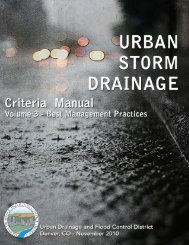Hydraulic Efficiency of Grate and Curb Inlets - Urban Drainage and ...
Hydraulic Efficiency of Grate and Curb Inlets - Urban Drainage and ...
Hydraulic Efficiency of Grate and Curb Inlets - Urban Drainage and ...
Create successful ePaper yourself
Turn your PDF publications into a flip-book with our unique Google optimized e-Paper software.
test data for typical design depths <strong>of</strong> 0.5 to 1 ft. A 5% reduction in average efficiency error was<br />
noted, <strong>and</strong> a 10% reduction in maximum efficiency error was noted for all test depths over the<br />
improved UDFCD methods. UDFCD methods for these inlets were shown to rely heavily on<br />
theoretical parameters that can not be physically determined by a user; parameters are instead<br />
determined from complex empirical relationships. A comparison between splash-over velocity<br />
curves developed for the Type 13 <strong>and</strong> 16 combination inlets <strong>and</strong> those for the most similar grate<br />
inlets from the USDCM revealed significant differences. The equations provided in the USDCM<br />
give an unrealistically high splash-over velocity (on the order <strong>of</strong> 30 ft/s) for a 10-ft Type 13 or 16<br />
combination inlet, which is in sharp contrast to the 4 ft/s determined from the test data. Original<br />
<strong>and</strong> improved UDFCD methods were most accurate at the lowest flow depth <strong>of</strong> 0.333 ft. Beyond<br />
that depth, the accuracy was very poor. This is likely due to the limitations <strong>of</strong> the FHWA model<br />
used to collect data for development <strong>of</strong> the equations. For the Type R curb inlet, the improved<br />
UDFCD methods were slightly better able to predict the observed efficiency data than the<br />
empirical equation for all test depths. A 1.2% improvement in average efficiency error was<br />
noted over the empirical equation, <strong>and</strong> a 15% reduction in maximum efficiency error was noted<br />
for all test depths. Typical design depths are 0.5 ft <strong>and</strong> greater for selection <strong>and</strong> placement <strong>of</strong><br />
street inlets (UDFCD, 2008). With this in mind, recommendations for which calculation method<br />
to use are given as follows: for the Type 13 <strong>and</strong> 16 combination inlets the empirical equations<br />
are recommended, for the Type R curb inlet the improved UDFCD methods are recommended.<br />
For illustration purposes, the observed test data on efficiency are plotted with the empirical<br />
efficiency <strong>and</strong> the efficiency determined from the improved UDFCD methods in Figure 6-1<br />
through Figure 6-3.<br />
78
















